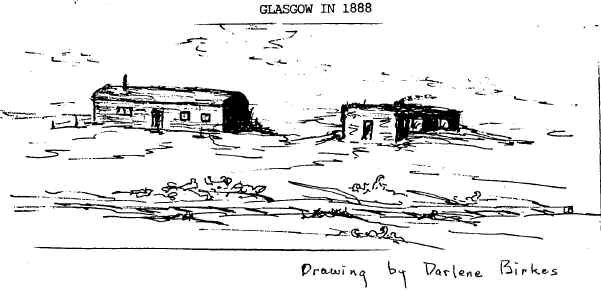|
|||||||
 |
|||||||
White Deer Land Museum 116 S. Cuyler Pampa, TX 79065 |
|||||||
 |
||||||
When Pampa Was Glasgow Real Audio by Eloise Lane The American explorer Randolph B. Marcy was near the
site of present Pampa in June, 1852, when he made his historic journey from his camp near present Lefors to the Canadian River. He struck out northwestward across the
Llano Estacado "where the eye rests on no object of relief within the scope of vision." M.K. Brown once told a reporter: "Prior to the coming of
the railroad, there was absolutely nothing but God's green earth where Pampa now stands." The site of present Pampa was one of the stations on the
route of the Southern Kansas Railroad. It was designated as Glasgow (Glas-ko), a name chosen by construction engineers to honor a banking firm located in Great Britain
as it was financing an American land holding company in the Panhandle of Texas. A blueprint, dated June 22, 1887, for station grounds at Glasgow is in the Square House Museum at Panhandle.
The first resident at Glasgow was Thomas Herbert Lane, section foreman and station agent for the railroad. The cellar and the sidetracked lumber which George Tyng had
seen at Glasgow were for the half dugout which Lane's family was to occupy. The dugout, which measured 14 feet by 24 feet, was described as being "more down than up." It was located
near the present Cuyler Street underpass (approximately 123 South Cuyler). Some accounts state that it was "in the middle of Cuyler Street." There was no Cuyler Street then.
In the immediate vicinity the only object that resembled a building was an old boxcar used as an "open station" for the railroad. The ground was covered with bones of great herds of
buffalo that had thundered over the plains only a few years previously. John Hetherly had a contract with White Deer Lands to haul bones to the station at Glasgow.
Cattle grazed over the area on which the streets of Pampa would be laid out. The catttle , the wind and the cowboys roamed unhampered over the plains.
There were a few settlers along the Canadian River and at locations that would later become the towns of Laketon, Lefors, McLean, Alanreed and White Deer. These early
settlers often told of traveling across "a sea of grass" which reached as high as their wagon beds. The "sea of grass" may have been covered with snow on
February 29, 1888, when Emma Case Lane came from Woodward, Indian Territory to join her husband at the Glasgow station. She was the first and, for about a year, the only woman resident. |
||||||
 |
||||||
With Emma were two sons: Ransom "Ray" Huntley Lane and Thomas "'Tommie" Vyr Lane. Ray was two and one half years old and Tommie was seven weeks old. Tommie
had been born in the railroad camp, a "tent city," at Woodward. Curious Indians had walked uninvited into the tent to look at the "little white papoose. At first groceries and other supplies
were shipped once a month from Kiowa, Kansas. Later it was possible to go to Mobeetie or Panhandle. Water was hauled in barrels, probably from a well drilled by the railroad at Miami. The water was sold for five cents a
bucket; only three buckets a day were allowed. Emma's grandchildren always remembered how she scolded them if they wasted water. Shacks were constructed on the right-of-way for the men who worked for the
railroad. The number of men at Glasgow is unknown, but an existing railroad pass was issued for the foreman and sixteen men. The men, who were paid $1.50 a day, usually rode the train to their homes on week-ends. When
they were at the Glasgow station, Emma cooked for them. Train crews coming from the west sometimes stopped at Glasgow before going on to Codman where they got off to dance. The trains were "mixed"
(both passenger and freight) and ran twice a week. Emma learned to send and receive messages necessary for operating the railroad. Cowboys often stopped at Glasgow before going to festivities at Mobeetie
where there were a number of saloons. Soldiers from Fort Elliott also frequented these saloons. In the early years at the railroad station, Emma was badly frightened several times. Once a group of Indians
made an appearance and sat silently until she thought to give them some food --- they were especially fond of bread. On another occasion a rattlesnake bit Ray on a leg. Before applying a poultice of tobacco,
Emma called to the railroad men who came to kill the snake. Emma was afraid of the lobo wolves that preyed on cattle. Near Miami, Matt Lewis collected many a bounty from cattlemen for killing these wolves,
On Grapevine Creek, Fannie Lovett placed her baby daughter Mattabel in front of her on the saddle and rode all day in the open trying to keep wolves away from the baby calves. In the spring of 1888,
settlers in the northeastern part of Gray County built a schoolhouse which is thought to be the first in the county. It became known as "Highwindy" because, while men were building it, a dust storm sent some
of the lumber tumbling across the plains. |
||||||
 |
||||||
On August 15, 1888, George Tyng, manager of White Deer Lands, wrote to trustee Frederic Foster, ... "the name of Glasgow has been changed to Sutton." Railroad officials chose the name
"Sutton" to honor Kansas resident M.V. Sutton who assisted in funding the construction of the railroad. The J.A. Paris story (F757 in GCH and p. 315 in RRI) indicates of Highwindy began in the fall
of 1888---had to stop in the winter--and that the dust storm and the completion of the building was in the spring of 1889. |
||||||

